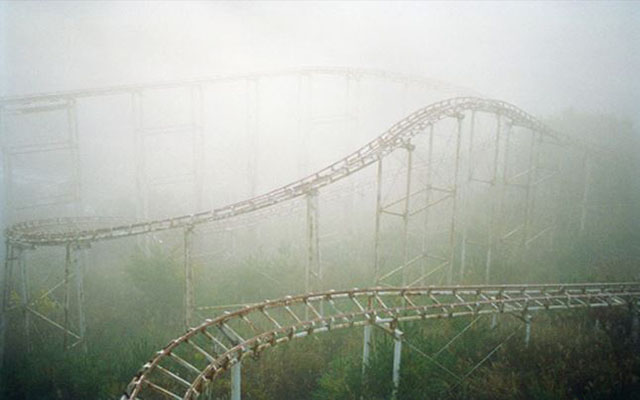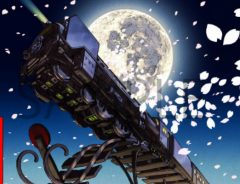
Source: imgur
Top 5 Cool And Scary Abandoned Spots In Japan! Abandoned Theme Parks, Haunted Mines, Creepy Islands, Hotels, And More!
- Source:
- Haikyo.org / TotoroTimes / Dailymail / Tumblr
Related Article
-

The Japanese Commercial Jingle That Will Never Leave Your Head
-

Show Your Love For Hello Kitty By Wearing Her Skull As Your Jewelry
-

Japan By Rail Tokyo To Kobe [Seishun 18 Day One]
-

Café Meguri in Japan: Get lost on the streets of Harajuku and try out the most recommended coffee shops
-

Japanese Baker Creates Beautifully Designed Breads Inspired By Her Son’s Drawings
-

Classic Manga “Space Battleship Yamato” And “Galaxy Express 999” Are Making A Comeback As Original Ukiyo-e Paintings


The imagery that comes to mind when thinking of Japan tends to fall in between two extremes: the sensationalist sights and sounds of a neon metropolis overflowing with anime, j-pop, and overall quirkiness--and the more tempered imagery of ancient temples, hot baths, and sprawling nature. Outside of these familiar stereotypes however, exists an untouched and abandoned world that provides some of the most creepy, but fascinating places in the country: Haikyo (廃墟).
In Japanese, "haikyo" simply means ruin, but the word has come to take on the meaning of urban exploration of abandoned areas as a spooky hobby. Many of these places are designated as off-limits due to various hazards, but that hasn't stopped adventurers around the globe from visiting and documenting these deserted (and sometimes rumored to be haunted) areas. Let's take a moment to indulge our natural love of creeping ourselves out and admire some haikyo!
1. Nara Dreamland
Perhaps the biggest name on the list belongs to Nara Dreamland, a Japanese theme park that was built in 1961 as a response to Disneyland's popularity. The park struggled with attendance numbers and was shut down in 2006. The abandoned attractions of the park look suspended in time, and it even feels as if cheerful parkgoers up and vanished without a trace.
Source: Dailymail
Source: Haikyo.org
Source: Haikyo.org
Source: Haikyo.org
Source: Haikyo.org
2. Takakanonuma Greenland
Another failed amusement park, Takakanonuma Greenland originally opened in 1973, but closed down just two years later. Officially, economic conditions and popularity struggles caused it to be left behind, but there are local rumors of several deaths occurring within the park. The park reopened for another stint between 1986 and 1999, but once again shut down. Since then, the surrounding forest in Fukushima has started to swallow up the desolate park, leaving attractions rotting and shrouded in an eerie Silent Hill-ish mist.
Source: imgur
Source: tumblr
Source: imgur
Source: tumblr
Source: tumblr
3. Gunkanjima (Battleship Island)
Gunkanjima, or Hashima, is an island that sits abandoned, roughly 15 kilometers from Nagasaki. Primarily known for its prison-like seawall and apartment blocks, the island was used for underground coal mines that were closed down in 1974. All residents left, and because of crumbling parts of island, access is limited. Like many haikyo spots, it finds itself rumored to be haunted—but you don’t really need anything more to find eerie about a deserted metropolis and abandoned coal mines! The island is strangely pretty, however, and has found itself and digital replicates of itself used in a few movies.
Source: Haikyo.org
Source: Haikyo.org
Source: Haikyo.org
Source: Haikyo.org
Source: Haikyo.org
4. Maya Hotel
One of the more famouse Haikyo spots in Japan, the Maya Hotel has been taken out of commission and restarted over and over again, but things never seemed to work out for the place. Call it cursed, but the hotel located just north of Kobe has been fire bombed, mudslided, and neglected until becoming permanently abandoned. Haikyo isn’t just about being creepy, so here is a place where you can witness a more beautiful kind of rot (it’s still kinda spooky though).
Source: Haikyo.org
Source: Haikyo.org
Source: Haikyo.org
Source: Haikyo.org
Source: Haikyo.org
5. Osarizawa Mine
Osarizawa Mine had to battle some other creepy contenders to grab this five spot (a theme park modeled after Gulliver’s Travels and an abandoned clinic with human organs in jars, for example), but I felt we needed to some color in here! Located in the forests of Akita Prefecture, the Osarizawa Mine was used for smelting copper and gold before closing down in 1978. The attractive pools you see are blue due to malachite and chemical run-off. While a lot of Haikyo is interesting because of what was once there, this particular one seems to make you wonder what we will leave behind.
Source: Haikyo.org
Source: Haikyo.org
Source: Haikyo.org
Source: Haikyo.org
Source: Haikyo.org
That'll be it for now--but if you ever want to see more, let us know and we'll show you! Or better yet, go check out Jordy Meow. He also has a collection of his work at Totorotimes. His website provided a lot of the beautiful photography you see used in this article--he has loads more of great Haikyo on his website! He also has a book called Abandoned Japan, where he documents this topic in detail. Enjoy!